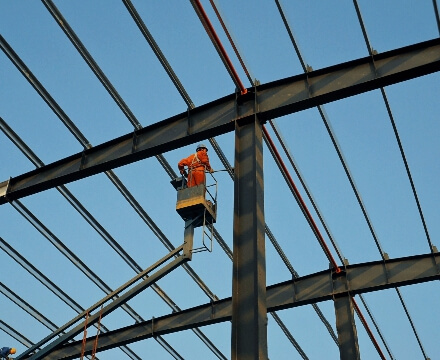Dapeng Town Industrial Park, Tongshan District, Xuzhou City, Jiangsu Province, China
In the construction stage of using steel structure, using the floor slab as the tensile reinforcement of the concrete slab can also improve the rigidity of the floor slab and save the amount of steel and concrete used. The embossing on the surface of the stamping plate produces a large bonding force between the real estate and the concrete, so that the two are integrated, and the reinforcing ribs are configured to make the real estate system have a higher bearing capacity. Profiled steel plate composite slab (floor deck, steel deck) is a very reasonable structural form with good seismic performance and construction performance. According to the position and characteristics of each component, the good advantages of steel tensile strength and concrete compressive performance are fully utilized. This structure has been widely used in multi-story buildings at home and abroad.

A steel beam is a long steel material with an I-shaped cross section. Its specifications are expressed in millimeters of waist height (h), foot width (b) and waist thickness (d). There are three kinds of light steel and h steel. H-shaped steel is widely used in various building structures, bridges, vehicles, brackets, machinery, etc.
After hot rolling and cold bending processing, 30% of the material can be saved under the same strength. The profiled steel purlins are divided into five specifications of 80, 100, 120, 140, and 160 according to the height, and are automatically processed by the C-shaped steel forming machine. The wall is thin, the weight is light, the section performance is excellent, and the strength is high. Compared with the traditional channel steel, the length can be determined according to the engineering design, but considering the transportation and installation conditions, the total length is usually not more than 12 meters. C-shaped steel is widely used in purlins and wall beams of steel structure buildings. In addition, it can also be used in columns, beams, arms, etc. in mechanical light industry manufacturing, and can also be combined into light-weight building components such as roofs and brackets.
The cross-section steel of the steel structure is optimized and developed to develop an economical cross-section steel with better cross-section mechanical properties, especially named because the cross-section is the same as the letter “h”. Section steel includes wide flange section steel (HW), medium flange h section steel (HM), narrow flange h section steel (HN), thin-walled h section steel (HT), and h section steel (HU). H-beam is a new type of economical construction steel. Compared with ordinary H-shaped steel, it has the advantages of large section coefficient, light weight, and metal saving. The section shape of section steel is economical and reasonable, and the mechanical properties are good. When rolling, the tension of each point on the section is relatively uniform, and the internal stress is small, which can save 25 % welding, riveting workload. It can reduce the building structure by 30-40%; In addition, because the inside and outside of the legs are parallel, the leg ends are at right angles, which can be assembled into components.
Square tube is a hollow square section lightweight thin-walled steel tube, also known as steel cold-formed section. Sectional steel with square cross-sectional shape and size made by high-frequency welding. In addition to the thickening of the wall thickness, the hot-rolled extra-thick square tube is formed by cold-bending with Q235 hot-rolled or cold-rolled strip or coil as the base material. It has good comprehensive mechanical properties, weldability, cold and hot processing properties and The corrosion resistance is good, and the corner size and edge straightness exceed the level of resistance welding cold-formed square tubes. Has good low temperature toughness. Square tubes are used in construction, machinery manufacturing, steel construction and other projects, shipbuilding, solar power plants, steel structure engineering, power engineering, power stations, agricultural and chemical machinery, glass curtain walls, automobile chassis, airports, boiler construction, highway railings, House construction, pressure vessels, square pipes.
Open at both ends, it has a section of hollow concentric circles whose length is longer than the perimeter. Its size ranges from a capillary with a small diameter to a large round steel pipe with a diameter of several meters. Round pipes can be used in pipelines, thermal equipment, machinery industry, petroleum geological drilling, containers, chemical industry and special purposes. Larger ones can be used for steel pipe concrete steel columns of heavy steel factory buildings, large-scale stadium pipe trusses, etc.; another main use of round steel is process pipes. Commonly used structural round steels vary according to their specifications and sizes, and small ones can be used for decorative components and prefabricated roofs. , supporting components, space frame and pipe trusses, etc., but generally have special material and anti-corrosion requirements.